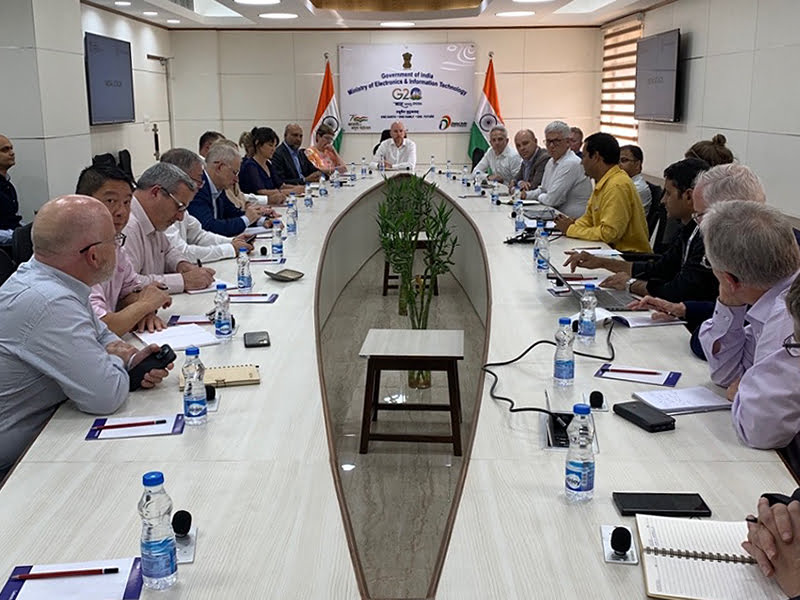Recent visits by the Australian and Indian Prime Ministers to each other’s country gives expression to Australia’s newfound relationship with India – a major power in the Indo-Pacific, the world’s fifth-largest economy and the largest democracy on the planet.
For the past decade, successive Australian governments and diplomats have been attempting to court India, seeking closer bilateral relationships with a free trade agreement seemingly unobtainable against the backdrop of dominant domestic politics for India’s part.
Due to hard work and the recent alignment of common geostrategic interests, it is significant that Australia has managed to secure a favoured relationship with India that most other countries do not have. For example, Australia is only one of three countries with whom India has an annual leader’s summit.
The Australia-India Economic Cooperation and Trade Agreement (ECTA), which entered into force in December 2022, will deepen our economic ties and provide further opportunities for Australian and Indian businesses.

Defence relationships are closer than they have ever been, with the India-Australia Joint Working Group on Defence Industry, Research and Materiel recently established alongside the Joint Working Group on ICT.
Prime Minister Anthony Albanese this year announced Indian skills recognition and fortified skilled migration pathways, including tech jobs only available to Indian citizens.
Finally, the Quad security dialogue brings traditional allies together with India to meet common strategic needs in the region. And a core pillar of the Quad, as with the AUKUS trilateral agreement, focuses on critical technologies such as Artificial Intelligence (AI) and Quantum technology.
It is well known that India is a technology superpower, with digital transformation and up-skilling core to the economic and social transformation that has been driven over the past decade.
With a workforce of over 500 million, including a tech workforce numbering 5.4 million – a figure equivalent to the population of Greater Sydney – India is powering innovation in multiple digital technologies, and is home to the third-largest start-up ecosystem in the world.
This landscape creates fertile opportunities for Australian tech companies – including in investment, research, partnering and exports.
With the deepening economic and defence ties between Australian and Indian governments, trade opportunities will grow for Australian companies, which up to now have looked east to America for export growth. Equally, they should now consider looking west.
The Australian Information Industry Association (AIIA) in early June led a delegation of senior Australian government and industry executives to India who met with global Indian, Australian and US tech companies with significant presence in Bangalore and Delhi.
Already, for large Australian banks, telecommunications and US tech companies, the majority of their global software engineering and development is carried out in India.
Australian companies alone have invested over $100 million into Indian operations and capability, with Telstra’s 2,500 Indian staff doing R&D and engineering as well as handset and 5G testing.
For other US companies that delegates visited, their Indian workforces were upwards of 90,000 and for the India tech companies who hosted us having the largest workforces, with Infosys’ employees numbering over 340,000.
From augmentation to innovation
What shone through in each company and government agency we visited was that India has some of the most highly skilled and trained people in the world.
India grew and developed a reputation initially for labour augmentation and business process outsourcing, but it is now the prime place in the world to innovate and do so at scale.
India is producing a staggering 2.14 million STEM graduates each year. By contrast, in Australia, we have 55,000 tech graduates, which is well below demand.
There are 9,000 tech startups in India, of which over 1,900 are AI startups.
Each of the seven companies that delegates visited reported the same single reason for operating in India: the talent of the people and the culture of ongoing learning and training, which serves as an embedded mindset.
Nowhere else on the planet can you tap into such a highly skilled and trained tech workforce at such scale. It is now the quality, not the price, of the skills that is driving the shift. India’s skilled workforce has moved from a means of augmentation to genuine innovation.
The India Stack: digital government at scale
One of the greatest public policy triumphs by a government anywhere in the world is surely the Prime Minister Narendra Modi-led universal digital identity (Aadhaar) and digital payments system (UPI) that sit at the foundation of what is known as the ‘India Stack’.
These two massive investments in public digital infrastructure have meant 1.4 billion Indians now have a secure digital identity that has paved the way for digital services and innovation at scale.
The UPI digital payments platform, as delegates heard from the Indian government’s Digital India agency, cost $3 billion to build but has generated $30 billion in savings to government from reduced leakage in government payments.
This is but one metric; there are numerous other benefits that result, for instance a citizen in a small town in India can transact at virtually no cost with their phone directly with another business or person instantly and securely, generating a credit history and creating an ability to access micro-loans as an industry-led over-the-top service.
The Indian government will now build out digital platforms covering health, education, transport and agriculture, driving continuous innovation across the economy.
One feature of the India Stack is that it is open source, grounded by the principle that government builds the core digital layer or infrastructure but then lets industry innovate to provide services and experiences directly to citizens and customers. The India Stack is a large reason why there are 9,000 tech startups in India.
India’s government partners for innovation
Delegates visited the Nasscom AI and IoT Centre of Excellence (CoE) in Bangalore, which highlighted how government and industry can partner to drive innovation.
Nasscom, the AIIA-equivalent industry association of India, has partnered with the Indian federal and state governments to stand up the AI-IoT CoE to drive innovation in these technologies to add to the 15 unicorns already unearthed from the India Stack story.
An interesting feature of the CoE is that at completion of their tenure in the CoE, the start-up can choose a government agency of their choice with which to partner and test their solution.
This partnering in delivering solutions with government is worth considering in the Australian context, where our startup labs from state governments and universities are yet to meet their full potential in generating scale-ups and successful IT business and unicorns.
Lessons for Australia
Australia can learn from India in numerous areas, from public policy – including how to foster innovation policy and ecosystem including disrupting financials payments systems and Australian businesses should also look for growth in India and not ignore its vast potential and market.
India is not scared by AI technologies, instead recognising this technology as a driver of innovation and productivity.
The Indian investment in STEM skills is driving the core of the modern India economic success story and Australia should embrace the benefits of this skilled workforce and benefits of global delivery centre models and not shy away from using these world-class software engineers.
This is not a matter of outsourcing jobs but rather innovating at scale and growing jobs in both countries.
We can do better in Australia in delivering digital public infrastructure. India is large geographically, culturally diverse, has a massive population and is federated, so if India can deliver modern digital public infrastructure, then Australia certainly can too.
A key learning is that national leadership from the top and a bold vision of what can be achieved is critical for success. It was also articulated to delegates that there was a social purpose behind the digital infrastructure investments and policy decisions.
A key feature was that the government layered in competition into the India Stack to empower industry to solve some of the problems and create new solutions and innovations.
The AIIA visited the following companies in India in June across Bangalore and Delhi: IBM, Infosys, Telstra Kyndryl, Nasscom AI-IoT CoE, HCL Tech, Adobe, Digital India and the Australian High Commission.
Simon Bush is Chief Executive Officer at the Australian Information Industry Association.







